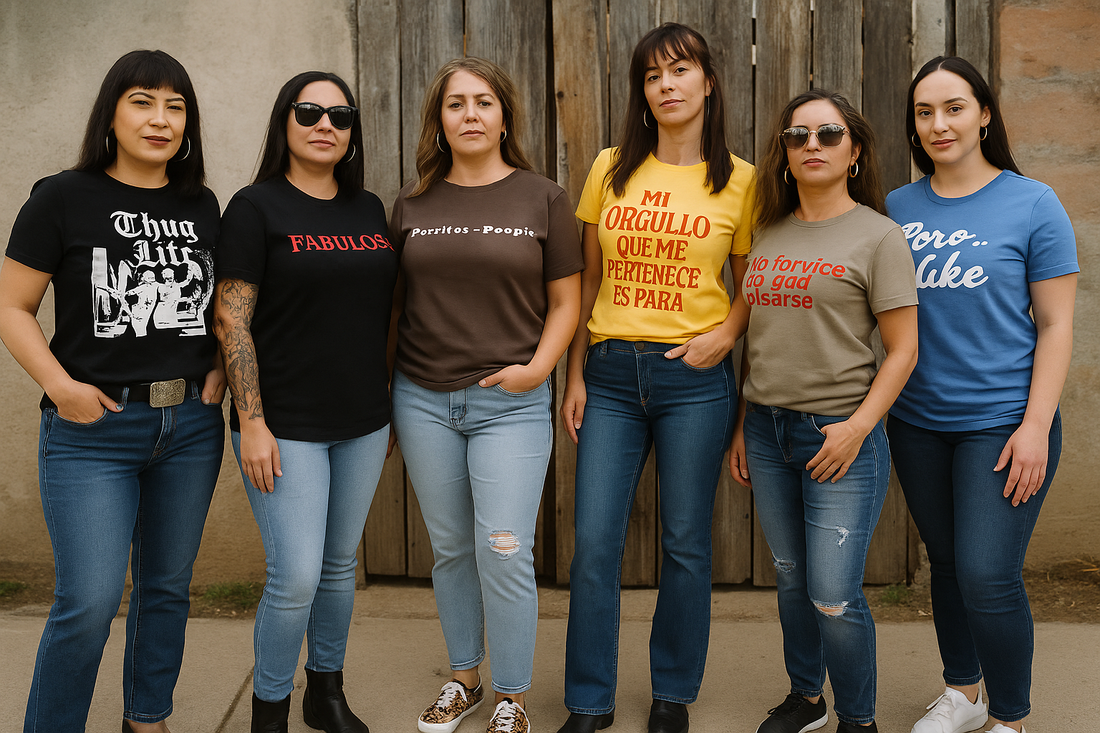
Latino Fashion as Resistance: A Cultural Style Rebellion
Share
Fashion has always been more than the fabric people wear. For Latino communities, clothing has been a way to declare identity, survive discrimination, and resist invisibility. The styles chosen by each generation have carried stories of migration, resilience, and defiance in societies that often tried to silence them.
Latino fashion holds political meaning because what is worn has rarely been separated from how Latinos were treated. From oversized zoot suits in the 1940s to bold streetwear and Spanglish statement tees today, fashion has consistently been used as a visible reminder that Latinos are present and proud. These choices were not just about style but about challenging systems that attempted to erase culture and dignity.
This history shows that every outfit can be more than personal taste. In Latino communities, dressing “cute” has often meant dressing with purpose. It has been a refusal to conform, a way to claim visibility, and a declaration that cultural pride cannot be ignored.
Read also: Latin Culture & Our Love for Perritos: A Match Made in Heaven
The Roots of Latino Fashion Resistance
Latino fashion resistance began as a response to both racism and assimilation pressures in the United States. In the 1940s, Mexican American youth used clothing to carve out a space of belonging and pride. One of the clearest examples was the adoption of zoot suits, a style that became a powerful form of rebellion. The baggy pants, long coats, and stylish hats were more than a fashion trend. They represented defiance against a society that demanded conformity while excluding Latinos from equal rights.
These suits also connected Latino youth with African American jazz culture, building solidarity across communities that faced similar discrimination. The jazz clubs of Harlem and New Orleans inspired the look, and Mexican Americans in Los Angeles made it their own by turning it into a badge of resistance.
Latina women also claimed space through style. Pachucas wore their own versions of the zoot suit, paired with bold makeup and hairstyles, openly challenging both gender norms and racial stereotypes. Their clothing made clear that they would not be confined to traditional roles. By stepping out in such striking attire, they turned fashion into a visible protest against the boundaries imposed on them.
The Zoot Suit Riots: When Clothing Became a Political Statement
-
What were zoot suits?
-
Baggy pants with high waists, long draped jackets, and pork pie hats
-
Inspired by African American jazz performers like Cab Calloway
-
Popular with Mexican American youth who called themselves Pachucos and Pachucas
-
Why did they spark controversy?
-
Seen as wasteful during World War II fabric rationing
-
Branded as “un-American” by the media and authorities
-
Associated with crime and delinquency, even without evidence
-
The Zoot Suit Riots of 1943:
-
White servicemen attacked Mexican American youth in Los Angeles
-
Victims were arrested while aggressors faced little punishment
-
Police and politicians criminalized Latino youth instead of protecting them
-
Lasting impact:
-
Wearing the suit became a symbol of cultural defiance
-
Helped lay the foundation for the Chicano Movement during the Civil Rights era
-
Proved that clothing could spark national conversations about race, identity, and belonging
The riots made it clear that Latino fashion was more than style—it was a political act. By refusing to give up their clothing, Mexican American youth demonstrated that visibility itself was resistance.
Chola and Chicano Style: Fashion in the Civil Rights Era
During the 1960s and 1970s, Chicano and Chola style developed into one of the clearest examples of fashion as identity and survival. These styles emerged in neighborhoods where Mexican Americans faced discrimination in schools, workplaces, and even public spaces. Clothing became a way to stand strong in the face of marginalization.
Chicano men often wore Dickies pants, plaid flannel shirts buttoned only at the top, and bandanas folded neatly over their heads. This look signaled belonging, unity, and pride in a shared identity. It was practical workwear but also symbolic, turning everyday clothing into a visible statement of community.
Chola women developed their own distinct style. They used bold makeup, thin, highly arched brows, brown lip liner paired with lighter lipstick, and dark eyeliner. Large hoop earrings and teased or slicked-back hair added to the look. These choices were powerful because they pushed against Eurocentric beauty standards that dominated the mainstream. At the same time, society often criminalized or mocked these styles, calling them signs of delinquency. But inside the community, they represented strength, sisterhood, and resilience. The Chicano and Chola look remains one of the most recognized forms of Latino fashion resistance.
Beauty as Resistance: Latina Women Rewriting Standards
-
Bold red lips and brown lip liner rejected Eurocentric beauty ideals and highlighted features often ignored by mainstream beauty culture.
-
Hoop earrings became a marker of Latina identity and pride, symbolizing visibility and strength.
-
Long acrylic nails and bold hairstyles pushed against “professional” beauty norms that demanded women look a certain way to be accepted.
-
Latina beauty choices were often labeled “ghetto” or “unprofessional,” even while the same trends were praised when adopted by celebrities outside the community.
These beauty practices were never just about appearance. They were statements of identity and defiance in spaces where Latinas were pressured to minimize themselves. By embracing these styles, women rejected the idea that only Eurocentric looks were valuable. Over time, what was once mocked or demonized became celebrated in fashion magazines and runways, though too often without credit to the women who pioneered them. This ongoing tension highlights how Latina women have long used beauty as both empowerment and protest.
Modern Latino Fashion: From TikTok to Streetwear
In today’s generation, fashion continues to be a form of protest and pride within Latino communities. Younger Latinas and Latinos are reclaiming styles once shamed or criminalized and turning them into symbols of power. Social media platforms like TikTok have amplified this shift, giving visibility to cultural expression on a global scale. What was once hidden or ridiculed is now proudly displayed as part of a collective movement to embrace heritage.
Examples of modern Latino fashion resistance include:
-
TikTok creators showcasing traditional clothing, braids, and streetwear looks while educating viewers about their cultural meaning
-
Spanglish graphic tees that carry slogans and statements, making identity visible and unapologetic
-
Incorporating cultural colors and patterns such as the Mexican flag, Aztec designs, or indigenous embroidery into everyday wear
Fashion today is not just about individual style. It is a way to claim space in schools, workplaces, and public platforms where Latino voices have often been overlooked. By choosing to dress in ways that honor heritage, modern Latinos are continuing a tradition of resistance that stretches back generations.
The Issue of Appropriation vs. Celebration
Latino fashion has long faced the challenge of appropriation. Styles that originated in working-class Latino communities were once criminalized, mocked, or dismissed, only to be praised years later when adopted by celebrities or mainstream fashion houses. Hoop earrings, brown lip liner, plaid flannels, and bold hairstyles are some of the clearest examples. When Latina women embraced these styles, they were often labeled as “ghetto” or “unprofessional.” Yet the same looks, once worn by non-Latino celebrities, were suddenly considered trendy or innovative.
This double standard reveals the racial and cultural bias that shapes fashion industries. Appropriation strips these styles of their history and context, turning them into marketable trends without acknowledgment of the communities that created them. On the other hand, celebration looks very different. True celebration involves recognizing where a style comes from, crediting its origins, and supporting Latina voices who continue to innovate within those traditions. Supporting Latina-owned brands, amplifying their stories, and respecting the cultural meaning behind their designs are essential steps toward honoring fashion as resistance rather than erasing it.
Latina-Owned Brands: Building the Future of Resistance
-
Keep cultural stories alive by embedding heritage, language, and pride into modern designs.
-
Provide alternatives to fast fashion’s appropriation by creating products that reflect authentic identity rather than watered-down imitations.
-
Give visibility to underrepresented voices by showcasing Latina creativity in an industry where their perspectives are often ignored.
Latina-owned brands are at the center of today’s movement to reclaim fashion as both cultural expression and protest. These businesses prove that clothing can carry meaning far beyond trends. For example, Ay Pero Qué Cute and other Latina-led labels use Spanglish, humor, and cultural references to make heritage visible and stylish. Wearing these designs is not only a personal choice but also a collective statement of empowerment. Every piece sold, every slogan printed, and every item worn in public challenges erasure and remind society that Latino culture is vibrant, resilient, and here to stay.
Conclusion: Dressing Proud, Dressing Loud
Latino fashion has never been only about looking good. It is history, identity, and resistance stitched into fabric and painted onto faces. From the zoot suits of the 1940s to the Chola style of the 1970s, and now to the bold streetwear and Spanglish tees of today, Latinos have used fashion to resist invisibility and demand recognition.
This tradition continues with a new generation that refuses to shrink or assimilate. Clothing remains a tool to honor culture, challenge stereotypes, and stand tall in the face of discrimination. The message is clear: Latino fashion is a celebration of survival and pride. Supporting Latina-owned brands ensures that these stories and symbols remain in the hands of the communities that created them.
Dressing proud and dressing loud is more than a choice of style; it is a declaration that Latino culture is powerful, beautiful, and impossible to ignore.
